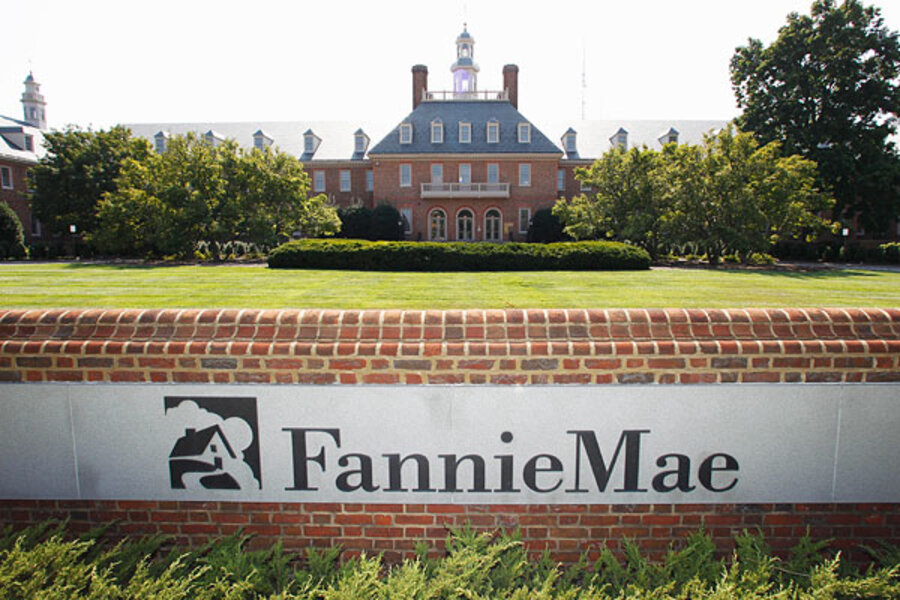Fannie Mae record profit: How long until it pays back bailout money?
Loading...
The mortgage giant Fannie Mae said it racked up its highest profit ever during the 2012 calendar year – a signal of housing-market recovery that raises hopes that US taxpayers will recover billions of dollars in bailout funds from the company.
Fannie Mae on Tuesday reported earnings of $17.2 billion for the year.
The firm, along with a sibling corporation named Freddie Mac, is at the heart of a US mortgage market that imploded during the financial crisis. The two firms received some of the biggest taxpayer bailouts in 2008.
But now, as housing markets are recovering, so are their fortunes.
Fannie Mae has drawn some $116 billion in financial support from the US Treasury since the firm was taken over in a federal conservatorship in 2008. Some $35.6 billion of that has, in effect, been paid back through dividend payments to the Treasury since 2009.
The company has paid a $4.2 billion dividend to the Treasury in the first quarter of 2013.
“We expect to remain profitable for the foreseeable future and return significant value to taxpayers,” said Susan McFarland, the firm’s chief financial officer, in releasing the new profit numbers.
In February, Freddie Mac gave a similar progress report of its own, banking $11 billion in net income for 2012. The firm has paid dividends totaling some $23.8 billion to the Treasury – or 33 percent of the company’s cumulative bailout draw – since conservatorship.
Paying back the full bailout funds is still a long way off for both firms.
And even if they achieve that goal, that doesn’t mean the bailouts would be cost-free. For one thing, economists say the rescues come with “moral hazard” attached. That term refers to the risk that the behavior of large financial firms will be guided somewhat that they can expect bailouts in future crises.
Still, the rescue of Fannie and Freddie symbolize policies that worked, in the view of many economists, to quell a spreading panic in financial markets that could have made the recession much deeper.
And, in the housing market in particular, Fannie and Freddie (along with the Federal Housing Administration) have acted as bulwarks of mortgage underwriting during the past five years, when other sources of credit had largely dried up.
Fannie and Freddie provide mortgage guarantees to private lenders, or purchase loans, when the loans conform to their standards.
The goal of helping to ensure a reliable flow of mortgage credit, even during hard times, is the reason Fannie and Freddie were created in the first place. Until the conservatorship, they operated with an unusual hybrid identity as investor-owned companies serving a Congress-created purpose.
Their futures remain in doubt. Congress must consider what role the government should play in providing Fannie- and Freddie-style loan guarantees in the future.
With the example of the bailouts in mind, many argue for downsizing any implicit taxpayer underwriting of the risk that home loans will go bad, as occurred in dramatic fashion in recent years. At the same time, other lawmakers say the market for home loans shouldn’t be left completely to soar and plunge on its own.
For their part, executives at Fannie and Freddie are touting the role they’ve played in buoying the housing market since the recession ended.
“Actions [by the company] have helped … to support the housing recovery by enabling families to buy, refinance, or rent a home even during the housing crisis,” Timothy Mayopoulos, Fannie’s chief executive officer, said in the company’s statement Tuesday.
Fannie Mae was involved in some 4 million new or refinanced mortgages in 2012, and Freddie Mac accounted for another 2 million.
With the housing market stabilizing and starting to recover since 2010, the share of Fannie-backed loans where borrowers are seriously delinquent on payments has been declining.
Some 3.3 percent of its single-family loans were in serious delinquency as of December, down from 5.5 percent in March 2010. The improvement stems partly from completing foreclosures, and partly from preventing foreclosures.






